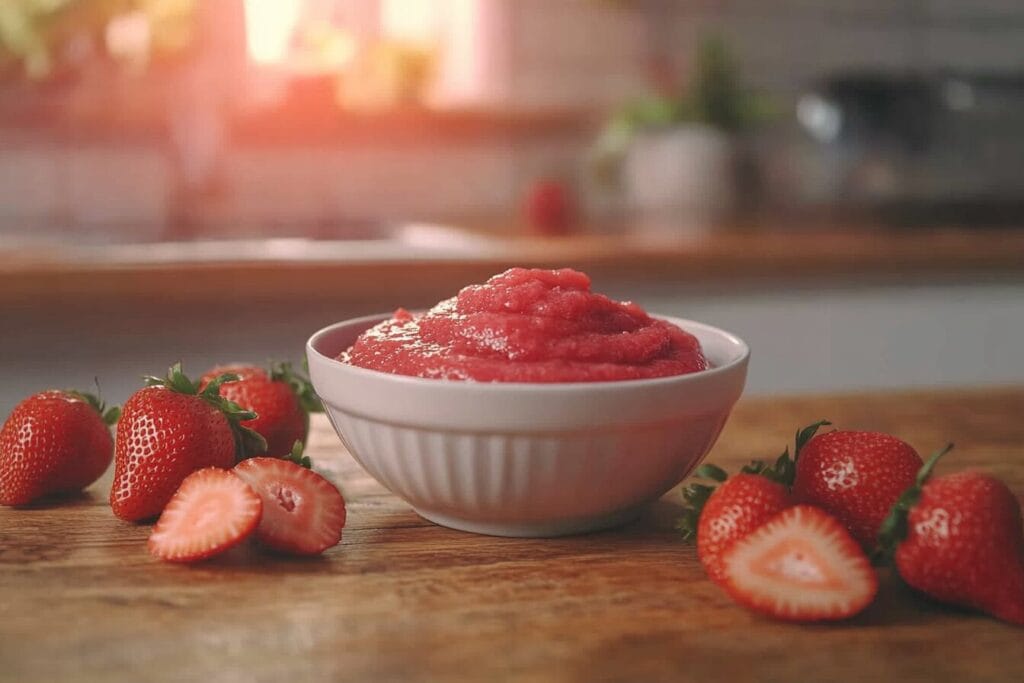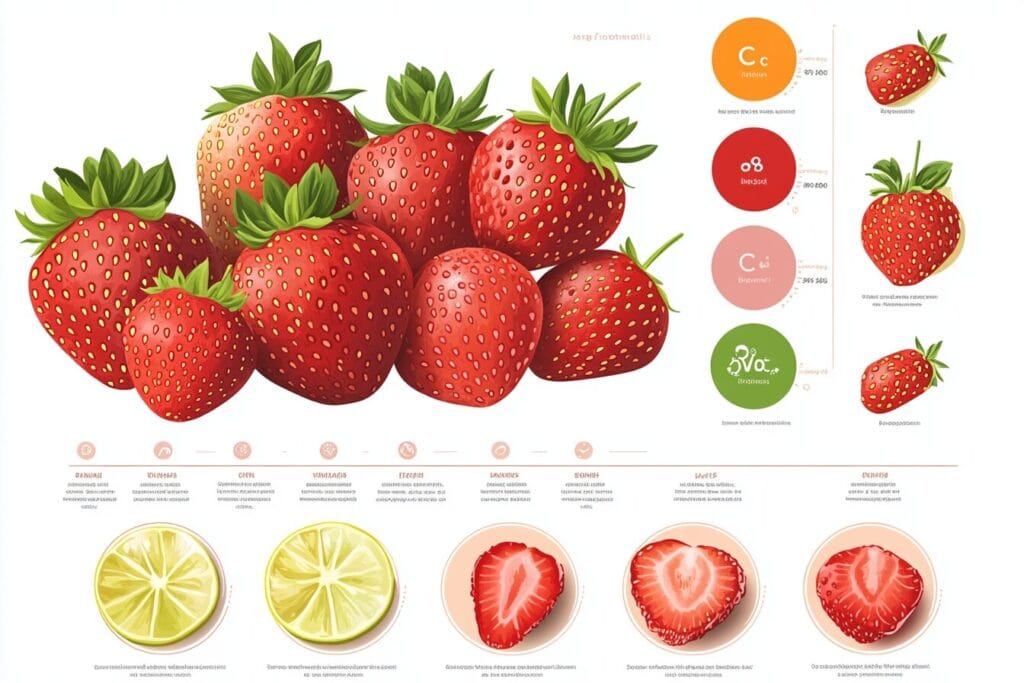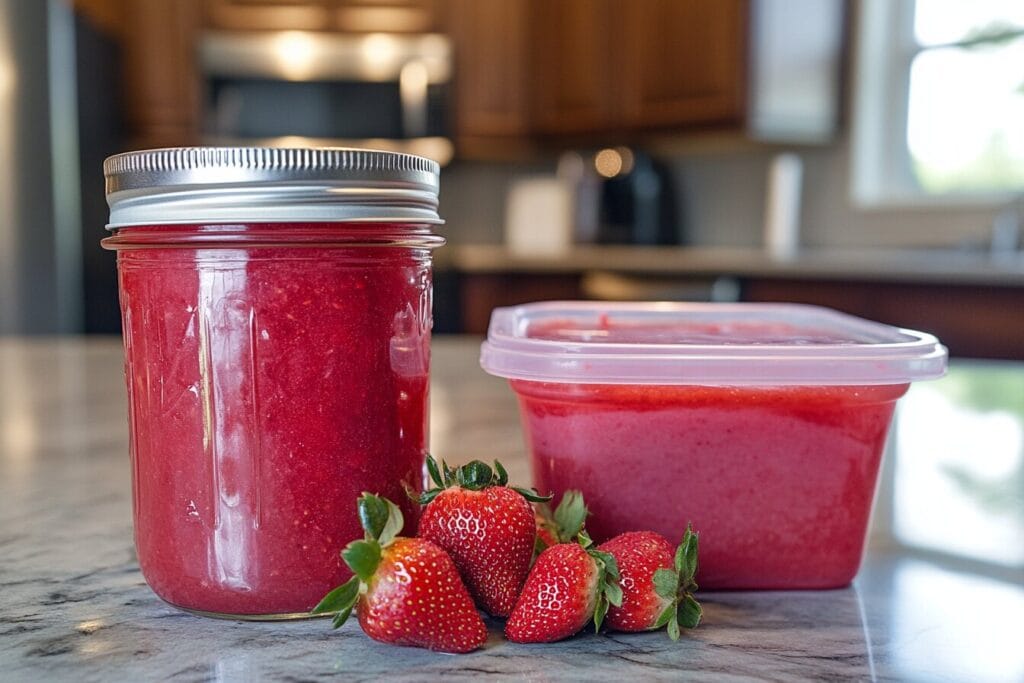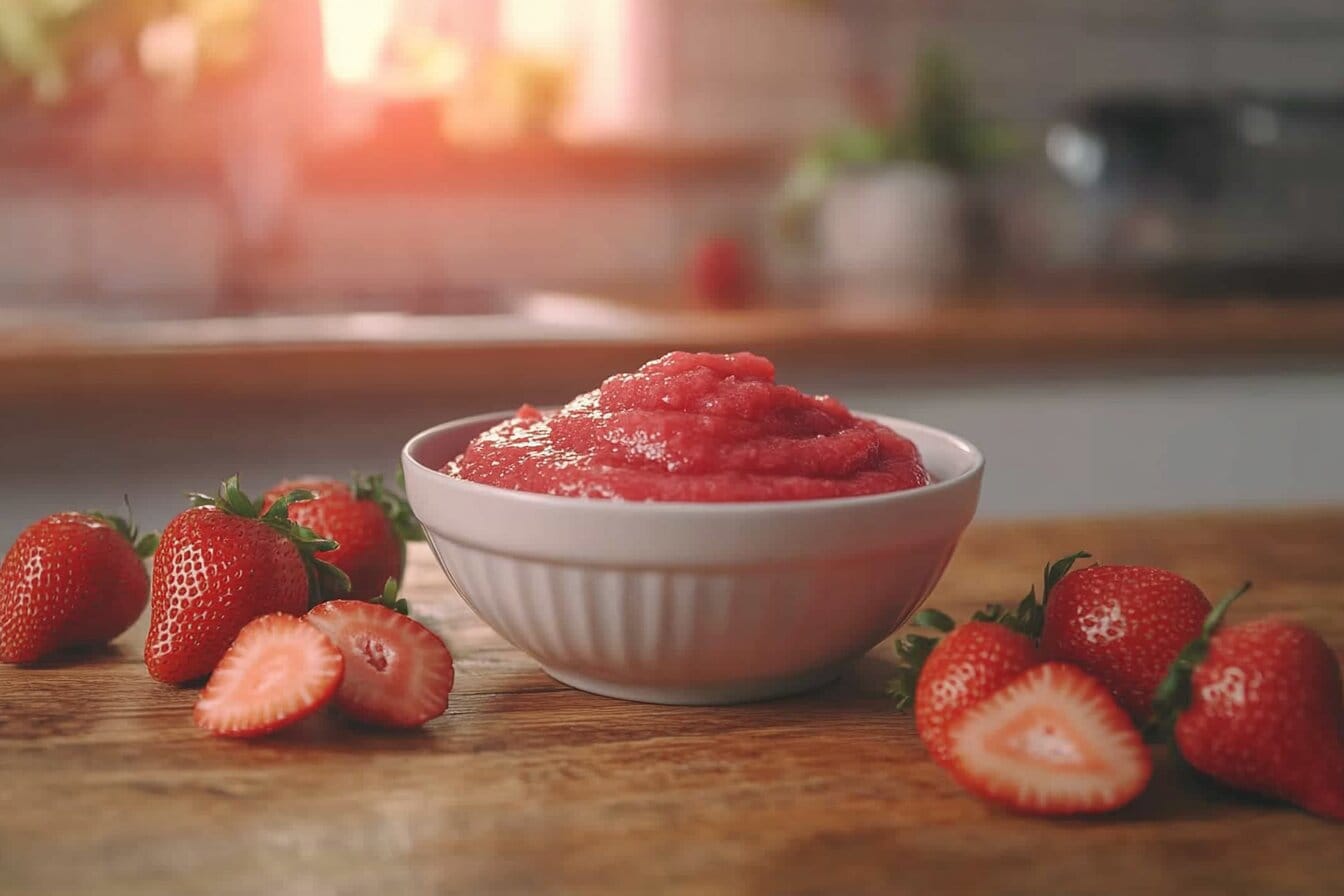Table of Contents
Strawberry puree is a versatile and flavorful addition to many recipes, enhancing everything from desserts and beverages to savory dishes. Whether you’re a home chef, baker, or simply curious, exploring how this puree is made and its nutritional value can deepen your appreciation for its simplicity. In this article, we’ll uncover the main ingredients in strawberry puree, its preparation methods, and why it’s a favorite in kitchens around the world.

Main Ingredients of Strawberry Puree
Strawberry puree is primarily made from ripe strawberries, but there are other ingredients and considerations depending on whether it’s homemade or store-bought.
Fresh Strawberries – The Heart of the Puree
The core ingredient of strawberry puree is, unsurprisingly, fresh strawberries. Naturally, the quality of the strawberries plays a crucial role in determining the flavor, texture, and vibrant color of the puree. For the best results, most recipes recommend selecting ripe and sweet strawberries, as these maximize the natural sweetness and enhance the overall taste. Moreover, when choosing strawberries, it’s important to avoid those that are overly soft or bruised, as they can negatively impact the puree’s quality. In addition, using in-season strawberries ensures a fresher and more robust flavor.
Optional Sweeteners – Sugar and Honey
To enhance the sweetness of the puree, some recipes call for additional sweeteners like sugar, honey, or agave syrup. While this is optional, it’s a common addition in desserts or smoothies.
Additives and Preservatives in Commercial Purees
Commercial strawberry puree often includes additives like citric acid to preserve color and flavor, or thickening agents like pectin. While these make the product shelf-stable, they differ from the all-natural homemade variety.
For more ideas on using strawberry puree, check out this comprehensive guide on strawberry puree health benefits, recipes, and creative uses.
Nutritional Value of Strawberry Puree
Strawberry puree is not just delicious but also packed with essential nutrients, making it a healthy addition to various dishes. Let’s explore the nutritional benefits and what makes this ingredient so valuable.

Vitamins and Minerals in Strawberries
Strawberries are nutrient-rich fruits, and their puree retains most of these benefits. Some of the key nutrients include:
- Vitamin C: A powerful antioxidant that supports the immune system and promotes healthy skin.
- Manganese: Essential for bone health and metabolism.
- Folate: Important for cell function and tissue growth, especially during pregnancy.
- Potassium: Helps regulate blood pressure and maintain fluid balance.
Additionally, strawberries contain small amounts of magnesium, iron, and vitamin B6, contributing to overall wellness.
For more fruit-based healthy alternatives, you might also be interested in learning about Concord grape juice benefits and everything you need to know.
Calorie and Sugar Content of Strawberry Puree
Strawberry puree is relatively low in calories, which makes it an excellent, guilt-free addition to a variety of meals. For instance, a 100-gram serving of unsweetened strawberry puree typically contains:
- Calories: Around 35-50, depending on the natural sweetness of the fruit used.
- Sugar: Naturally occurring sugars range between 5-7 grams per 100 grams of puree, offering a subtle sweetness without the need for added sugars.
Moreover, because it is naturally low in fat and rich in essential nutrients, strawberry puree can be a fantastic choice for those looking to maintain a healthy and balanced diet. In addition, its versatility allows it to complement both sweet and savory dishes without significantly increasing the calorie count. As a result, it’s a popular option for health-conscious individuals who enjoy indulging in flavorful, yet nutritious, meals.
Adding sweeteners like sugar or honey increases the calorie and sugar content, so it’s best to use them sparingly if you’re watching your intake.
Health Benefits of Using Natural Strawberry Puree
- Antioxidant Properties: Strawberries are rich in antioxidants like anthocyanins and ellagic acid, which help combat oxidative stress and inflammation.
- Heart Health: The potassium and fiber in strawberries may lower blood pressure and improve cholesterol levels.
- Weight Management: Low in calories and high in fiber, helps promote satiety and can be included in a weight-loss diet.
- Skin Benefits: Vitamin C supports collagen production, keeping skin youthful and firm.
Why Choose Homemade Puree for Nutritional Benefits?
Homemade strawberry puree is free from artificial additives and preservatives, ensuring that you get all the natural nutrients without any unwanted chemicals. It’s an excellent choice for health-conscious individuals or those with dietary restrictions.
How to Make Strawberry Puree at Home
If you’re wondering how to make strawberry puree at home, you’ll be pleased to know it’s a simple and rewarding process. Below is a step-by-step guide to creating your own fresh puree.
Step-by-Step Guide :
- Ingredients You’ll Need:
- 2 cups of fresh, ripe strawberries.
- Optional: 1-2 tablespoons of sugar or honey for sweetness.
- Optional: 1 teaspoon of lemon juice to enhance the flavor and preserve color.
- Preparation Steps:
- Step 1: Wash and hull the strawberries to remove the green tops.
- Step 2: Slice the strawberries into smaller pieces for easier blending.
- Step 3: Place the strawberries in a blender or food processor. Add sugar or honey if desired.
- Step 4: Blend until smooth. For a thinner consistency, add a tablespoon of water.
- Step 5: Taste the puree and adjust sweetness if needed.
- Straining (Optional):
- If you prefer a smoother texture, pass the puree through a fine mesh strainer to remove seeds.
- Storage Tips:
- Store the puree in an airtight container in the refrigerator for up to 5 days.
- Freeze in ice cube trays for longer storage, making it easy to use small portions as needed.
Tips for Selecting the Best Strawberries
- Seasonal Produce: Buy strawberries during their peak season for the best flavor.
- Bright Red Color: Choose berries that are deep red, firm, and free of bruises.
- Aromatic Smell: Fresh strawberries should have a sweet, fragrant aroma.
Variations of Homemade Strawberry Puree
- Unsweetened Puree: Skip the sugar for a natural flavor, perfect for baby food or health-conscious recipes.
- Spiced Puree: Add a pinch of cinnamon or vanilla extract for a unique twist.
- Mixed Berry Puree: Blend strawberries with other berries like raspberries or blueberries for a flavorful combination.
Expanded Uses of Strawberry Puree
Strawberry puree’s versatility makes it a culinary staple, enhancing a wide variety of dishes and beverages. From desserts to savory meals, and from breakfast to drinks, this ingredient brings color, flavor, and nutrition to countless recipes. Below, we’ll explore its many applications in greater detail to inspire your creativity in the kitchen.
Strawberry Puree in Desserts – A Sweet Delight
- Cakes and Pastries:
- Use strawberry puree as a filling for sponge cakes or Swiss rolls.
- Combine it with gelatin to create a strawberry mousse layer in cheesecakes.
- Drizzle over brownies or blondies for a fruity contrast.
- Pies and Tarts:
- Use the puree as a glaze for strawberry tarts or fruit pies.
- Blend with cornstarch and sugar to make a silky tart filling.
- Frozen Desserts:
- Freeze the puree into popsicle molds for refreshing strawberry ice pops.
- Swirl it into homemade frozen yogurt or gelato for a marble effect.
Beverages – Elevate Your Drinks with Strawberry Puree
- Smoothies and Protein Shakes:
- Blend strawberry puree with Greek yogurt, bananas, and milk for a nutrient-packed smoothie.
- Add it to protein shakes for a fruity twist.
- Cocktails and Mocktails:
- Stir it into champagne or prosecco for a strawberry bellini.
- Mix it with lime juice and soda water for a refreshing mocktail.
- Flavored Coffee and Tea:
- Add a dollop of strawberry puree to iced tea for a fruity variation.
- Stir it into cold brew coffee with milk for a strawberry latte.
- Juices and Waters:
- Combine the puree with sparkling water and mint for a homemade strawberry soda.
- Use it as a natural flavor enhancer for infused water.
Strawberry Puree in Breakfast and Brunch
- On Pancakes, Waffles, and French Toast:
- Pour warm strawberry puree over pancakes and waffles instead of syrup.
- Add whipped cream for a decadent breakfast option.
- Yogurt and Parfaits:
- Swirl the puree into plain yogurt for a naturally sweetened alternative to flavored yogurts.
- Layer it with granola and fresh fruit for a nutritious parfait.
- Oatmeal and Cereal:
- Mix strawberry puree into oatmeal or overnight oats for added flavor.
- Use it as a topping for granola or muesli.
- Toast and Bagels:
- Spread it on toast with almond butter or cream cheese.
- Use it as a layer in bagel sandwiches with mascarpone and fresh fruit.
If you love pancakes, try this easy pancake recipe.
Strawberry Puree in Savory Dishes – A Surprising Twist
While strawberry puree is most commonly associated with sweet dishes, it also works beautifully in savory recipes, adding a hint of sweetness and acidity to balance flavors.
- Salad Dressings:
- Drizzle over spinach salads with goat cheese, walnuts, and strawberries.
- Marinades and Glazes:
- Combine it with soy sauce, garlic, and ginger for a marinade that pairs well with grilled chicken or pork.
- Use it as a glaze for roasted vegetables like carrots or Brussels sprouts.
- Dipping Sauces:
- Serve it alongside fried appetizers like chicken tenders or spring rolls.
Strawberry Puree as a Topping or Mix-In
- Ice Cream Topping:
- Pour the puree over scoops of vanilla or chocolate ice cream for a fruity finish.
- Add fresh strawberry slices for extra texture.
- Cheesecake and Puddings:
- Drizzle the puree over cheesecake slices to balance the richness.
- Swirl it into rice pudding for added flavor and color.
- As a Spread:
- Use it as a spread on scones, muffins, or cornbread.
- Mix it with butter to create strawberry-flavored compound butter.
- For Baked Goods:
- Add it as a filling in homemade donuts or croissants.
- Fold it into batter for cakes and muffins to enhance moisture and flavor.
Strawberry Puree in Commercial Uses
- Packaged Snacks:
- Found in granola bars, fruit snacks, and yogurt squeezes marketed for children.
- Flavored Dairy Products:
- Used to create strawberry-flavored milk, yogurt, and ice cream.
- Sauces and Condiments:
- Incorporated into barbecue sauces and chutneys for gourmet flavor profiles.
Store-Bought vs. Homemade Strawberry Puree
When deciding between store-bought and homemade strawberry puree, it’s essential to weigh factors such as taste, quality, cost, and convenience. Both options have their advantages and drawbacks, so let’s explore them in detail.

Differences in Flavor and Quality
- Homemade :
- Made with fresh, ripe strawberries, delivering a vibrant, natural, and authentic flavor.
- Free from artificial additives and preservatives, allowing the pure, natural taste of strawberries to shine.
- Store-Bought :
- Often includes preservatives like citric acid and added sugars, which can affect the flavor and make it less natural.
- Provides convenience for quick recipes but may lack the freshness and full-bodied flavor of homemade puree.
Cost Comparison
- Homemade Puree:
- Typically more budget-friendly, especially when strawberries are in season and readily available.
- You control the amount produced, reducing waste and ensuring just the right quantity for your needs.
- Store-Bought Puree:
- Can be more expensive due to processing, packaging, and added preservatives.
- Widely available throughout the year, even when fresh strawberries are out of season.
Shelf Life and Storage Tips
- Homemade Puree:
- Stays fresh for 3-5 days in the refrigerator when stored in an airtight container.
- Freezing is a great option for extended storage—freeze in small portions (such as ice cube trays) for up to 3 months.
- Store-Bought Puree:
- Preservatives significantly extend its shelf life, making it a more practical option for long-term use.
- Often contains stabilizers or added sugars, which may not be suitable for those looking for a healthier, more natural product.
By understanding the differences between homemade and store-bought strawberry puree, you can choose the option that best fits your needs. Homemade puree offers unparalleled freshness and control, while store-bought puree provides convenience and year-round availability.
FAQs
What is Strawberry Puree Made Of?
Strawberry puree is primarily made from fresh, ripe strawberries blended into a smooth consistency. Additional ingredients such as sugar, honey, or lemon juice are sometimes included for sweetness or to preserve freshness. Store-bought versions may also contain preservatives and stabilizers to extend shelf life.
Can Strawberry Puree Be Made Without Sugar?
Yes, strawberry puree can absolutely be made without sugar. By opting for naturally sweet, ripe strawberries, you can create a flavorful and delicious puree without the need for additional sweeteners. Not only does this highlight the fruit’s natural taste, but it also makes the puree a healthier option. This unsweetened version is particularly ideal for health-conscious recipes, where controlling sugar intake is important, and it’s also perfect as a wholesome choice for baby food. Furthermore, without added sugar, the puree retains its versatility, allowing it to be used in both sweet and savory dishes, such as smoothies, sauces, or salad dressings.
How Long Does Homemade Strawberry Puree Last?
To reduce keyphrase density without compromising SEO, focus on diversifying the language. Replace exact matches of the focus keyphrase (“What is strawberry puree made of”) with synonyms and related phrases. Here’s an edited version:
Is Strawberry Puree Healthy?
Yes, this fruit-based puree is healthy when made without added sugars or artificial ingredients. It’s low in calories, high in vitamin C, and packed with antioxidants and fiber, making it a nutritious option for any diet.
Can Strawberry Puree Be Used for Babies?
Strawberry puree is an excellent choice for babies, especially when prepared without sugar or additives. Introduce it to infants around 6-8 months of age, after consulting with your pediatrician, to ensure there are no allergies.
What Are Some Creative Ways to Use Strawberry Puree?
There are countless ways to incorporate strawberry puree into your meals. For instance, you can swirl it into yogurt or oatmeal to give your breakfast a fruity boost. Additionally, it works wonderfully as a topping for cheesecakes, pancakes, or waffles, adding both flavor and visual appeal. Moreover, strawberry puree can be blended into cocktails, mocktails, or smoothies to enhance their taste and provide a refreshing twist. Finally, consider drizzling it over grilled meats or roasted vegetables to create a sweet and tangy glaze that balances savory flavors beautifully.
Conclusion
Strawberry puree is a versatile ingredient that enhances the flavor and texture of a wide variety of dishes. Made primarily from ripe strawberries, it retains their natural sweetness and bright color. Whether homemade or store-bought, this puree offers endless culinary possibilities, from sweet treats to savory meals.
Homemade versions allow you to control the sweetness and avoid preservatives, while store-bought options provide convenience for busy cooks. No matter how you use it—whether as a dessert topping, a drink base, or a savory glaze—strawberry puree brings a delightful burst of flavor to your kitchen

